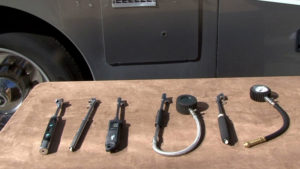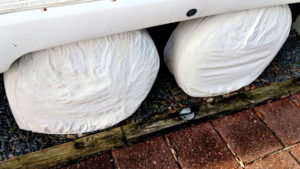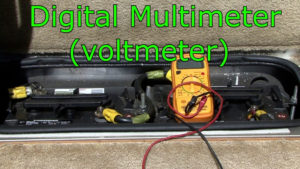rv Education 101
RV Education 101 Shares Tools to Protect your RV During Storage
Hi, I’m Mark Polk with RV Education 101. When the time comes to put your RV in short or long-term storage, there are a few products that help make the task easier. Let us take a look.
 Tire pressure gauge. A good quality RV tire pressure gauge is an essential tool for RV owners. When it comes time to store the RV, inflate the tires to the manufacturer’s recommended max cold pressure. Tires in storage can lose two to three PSI per month, so it’s important to check and adjust the tire inflation pressure when you take the RV out of storage too. Tire blocking. While we are on the topic of tires, if the RV is stored on the ground or on pavement, put the tires on some type of blocking. The blocking needs to be wider than the footprint of the tire to protect the tires from damage.
Tire pressure gauge. A good quality RV tire pressure gauge is an essential tool for RV owners. When it comes time to store the RV, inflate the tires to the manufacturer’s recommended max cold pressure. Tires in storage can lose two to three PSI per month, so it’s important to check and adjust the tire inflation pressure when you take the RV out of storage too. Tire blocking. While we are on the topic of tires, if the RV is stored on the ground or on pavement, put the tires on some type of blocking. The blocking needs to be wider than the footprint of the tire to protect the tires from damage.
 Tire covers. Another important tire related product is tire covers. If the RV is stored outside, exposed to the elements, tire covers will protect the tires from the sun and the harmful UV rays.
Tire covers. Another important tire related product is tire covers. If the RV is stored outside, exposed to the elements, tire covers will protect the tires from the sun and the harmful UV rays.
RV cover. If the RV is stored outside, try to avoid parking it under trees or in areas where grass and weeds grow. The sun and other elements can damage your RV. The best investment you can make for an RV stored outside is a quality RV cover. The cover should be made of a breathable material to help promote air circulation and prevent mold and mildew. You can purchase a cover made specifically for the size and type of RV you have.
 Digital multimeter. Another essential tool for RV owners is a digital multimeter. Like tires, a battery in storage can lose up to 10% of its charge every month. When a battery is in a low state of charge, small crystals start forming on the plates. This is call sulfation. And if it remains in this condition for an extended period of time without recharging, the battery is ruined. Sulfation starts when a battery’s state of charge drops below 80% or 12.4 volts for a 12-volt battery. To prevent this from happening, you can measure the voltage using a digital volt meter every month. Measuring the voltage gives you a quick picture of the battery’s depth of discharge so you know when the battery needs to be recharged. Set the volt meter on DC voltage, and place the red lead on the positive terminal and the black lead on the negative terminal to read battery voltage. A fully charged 12-volt battery will read 12.7 volts. Any battery at or below 12.5 needs to be recharged immediately. Battery charger maintainer and conditioner. Newer RVs come equipped with a three stage battery charger. This means the built-in charger will charge the battery without damaging it. If your RV doesn’t have a three stage battery charger, or if you don’t want to constantly worry about the battery when it’s in storage, you can purchase some type of battery charger, maintainer, and conditioner. I personally use BatteryMINDer products, but there are other products available like the Battery Tender. You simply connect the BatteryMINDer
Digital multimeter. Another essential tool for RV owners is a digital multimeter. Like tires, a battery in storage can lose up to 10% of its charge every month. When a battery is in a low state of charge, small crystals start forming on the plates. This is call sulfation. And if it remains in this condition for an extended period of time without recharging, the battery is ruined. Sulfation starts when a battery’s state of charge drops below 80% or 12.4 volts for a 12-volt battery. To prevent this from happening, you can measure the voltage using a digital volt meter every month. Measuring the voltage gives you a quick picture of the battery’s depth of discharge so you know when the battery needs to be recharged. Set the volt meter on DC voltage, and place the red lead on the positive terminal and the black lead on the negative terminal to read battery voltage. A fully charged 12-volt battery will read 12.7 volts. Any battery at or below 12.5 needs to be recharged immediately. Battery charger maintainer and conditioner. Newer RVs come equipped with a three stage battery charger. This means the built-in charger will charge the battery without damaging it. If your RV doesn’t have a three stage battery charger, or if you don’t want to constantly worry about the battery when it’s in storage, you can purchase some type of battery charger, maintainer, and conditioner. I personally use BatteryMINDer products, but there are other products available like the Battery Tender. You simply connect the BatteryMINDer
to the RV battery and let it do its job. It will charge, maintain, and condition the battery, preventing sulfation, but it will never overcharge the battery.
RV roof vent covers. I recommend installing roof vent covers like MaxxAir vent covers over the existing roof vents on the RV. These vent covers allow you to open the roof vent for ventilation while the RV is in storage without worrying about rain getting inside the RV. If you install two vent covers on opposite ends of the RV, it will help promote cross-ventilation
throughout the RV while it’s in storage.
Rodent control products. A common problem when the RV is in storage is rodent control. Inspect the underside of the RV thoroughly. Look for anywhere mice or other rodents can get inside. Mice only need a dime size hole to get in the RV, so inspect the exterior and interior closely. Seal any openings using silicone or a spray foam product from a home improvement store. There are lots of aftermarket products for controlling rodents like Sniff n’ Stop or Mothballs. But if you live close to where the RV is stored and can check the RV frequently, mousetraps are effective, too. Remove all consumables that would attract mice and other rodents, and remove all perishables and anything that can freeze.
Defrost the freezer compartment and clean the refrigerator. Leave the refrigerator doors propped open and place some baking soda inside the refrigerator compartment to absorb odors.
RV marine antifreeze. The biggest problem during cold weather storage by far is the potential for the RV plumbing system to freeze, expand, and break if the plumbing system is not protected. The best way to protect it is by winterizing the RV plumbing system using an RV marine antifreeze. Winterizing your RV is not a difficult job. And if you want to tackle the job yourself, check out our video and eBook training at rvonlinetraining.com.
Happy camping from Mark Polk of RV Education 101

